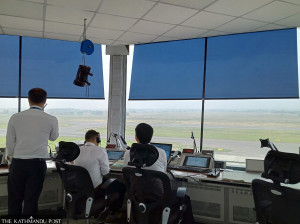Columns
Riparian governance
South Asia’s priority must be conserving the Himalayan region that sustains its rivers.
Aisha Khan
As we edge dangerously close to crossing planetary boundaries, it is crucial to recognise water’s central role—not just as a life-sustaining resource but also as a trigger for conflicts that can escalate into wars. Rapid changes in the hydrological cycle, originating from the cryosphere, are intensifying and cascading down to impact human security in profound ways. Our dependence on water for sustaining ecosystems and human livelihoods means that any steady decline in its availability will set off a cascade of actions and reactions, greatly affecting how nations plan and perceive security.
This tension is particularly acute in South Asia, a region marked by a conflicted history, rapidly melting glaciers and escalating tensions over water-sharing arrangements. The key rivers of South Asia—the Indus, Ganges and Brahmaputra—all originate in the Himalayas, a fragile and geopolitically sensitive mountain range.
The Indus, the largest river in South Asia, spans about 3,200 kilometres and boasts an annual flow of roughly 243 cubic kilometres—twice that of the Nile and three times the combined flows of the Tigris and Euphrates. Originating in China at an elevation of 5,500 metres, it receives most of its water from snow and glacial melt in the upper catchments located in India, making it a vital lifeline for Pakistan.
The Ganges rises from the Gangotri glacier in Uttarakhand, flowing through northern India. It is nourished by rainfall, subsurface flows and snowmelt. At about 2,500km long, it supports the most densely populated river basin in the world. The Brahmaputra, known as the Yarlung Zangbo in China, flows for about 2,900km through Tibet and India, merging with the Ganges in Bangladesh before emptying into the Bay of Bengal.
The hydrological geography of the region means each country assumes an upper or lower riparian status. China sits atop this hierarchy as the upper riparian to India and Bangladesh, with India positioned as the upper riparian to Pakistan. While Nepal and Afghanistan are also riparian states, their influence on downstream flows is relatively limited and does not currently pose significant risks to regional stability.
Geography and geopolitics are at odds at a time when transnational challenges fuelled by climate change are exacerbating risks. Positioned as a midstream, mid-riparian nation, India has a unique opportunity—and responsibility—to act as a stabilising force. Through equitable management of riparian relations with both its upper and lower neighbours, India can help ease tensions and foster peace in a volatile region.
In a multipolar world, South Asia’s foremost priority must be the conservation of the Third Pole—the Himalayan region that sustains the Indus, Ganges and Yangtze rivers, all among the 10 most endangered rivers globally. The Ganges basin covers nearly one-third of India’s land area, while the Indus basin accounts for roughly 65 per cent of Pakistan’s land area (approximately 520,000 square kilometres), spanning all provinces and territories. The Yangtze, Asia’s longest river, courses through China for 6,300km, draining 1.8 million square kilometres and sustaining significant arable land before reaching the East China Sea.
These rivers are lifelines for billions of people, and any disruption to their flows—especially from cryosphere melt—would have devastating consequences. While China is not part of South Asia, it remains a strategic regional player whose policies significantly impact neighbourhood politics.
Water geopolitics will increasingly shape how countries position themselves politically, militarily and economically to secure water resources. The three critical watershed points—located in the Kunlun, Himalaya and Karakoram mountain ranges—hold immense geopolitical significance and offer potential entry points for dialogue, enabling political disputes to be resolved and fostering pathways for peaceful water-sharing solutions.
Glaciers, often called the best barometers of global warming, also serve as an early warning system for political strategising. Clearly, water wars are not a solution, and ongoing hostility will only exacerbate instability. The resolution of the looming water crisis demands collaborative riparian governance built on trust, transparency and shared responsibility.
China, with its advanced technological and economic capabilities, is best positioned to lead regional efforts on water conservation and glacier preservation. Having met 15 of the 17 Sustainable Development Goals, China can spearhead the first regional Conference of Parties (COP) focused explicitly on the cryosphere and water-related issues. This platform could develop a shared roadmap aimed at preventing water conflicts and fostering sustainable management of transboundary rivers.
While South Asian countries should continue active participation in global climate forums such as the United Nations Framework Convention on Climate Change COPs, it is time to pivot towards Asia-centric solutions. A regional COP dedicated to water adaptation would prioritise resilience-building, enhance water security and reduce the risk of destabilisation in a region with three nuclear-armed states. The international community’s focus on mitigation remains vital, but adaptation through regional cooperation will address the unique and urgent challenges faced by South Asia.
Water conflicts are ultimately solvable with political wisdom, diplomacy and a clear understanding of the grave consequences of crossing red lines. Issues left unresolved tend to resurface, often with greater intensity. Relying on a ‘balance of terror’ as the new normal is a high-risk gamble that could destabilise the region irreparably.
The solution lies in collective governance, trust-building, and scientific cooperation—frameworks that allow riparian nations to share data, co-manage resources and develop contingency plans for changing hydrological realities. In doing so, South Asia can transform water from a potential source of conflict into a foundation for peace and sustainable development.
-Dawn (Pakistan)/ANN




 20.23°C Kathmandu
20.23°C Kathmandu

















